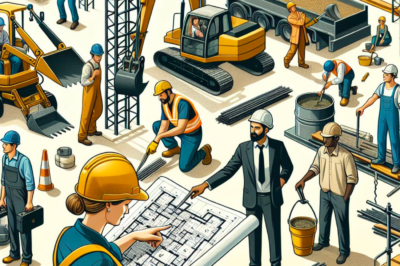
Key Takeaways
- Construction skill shortages are a pressing issue that can lead to project delays and increased costs.
- Understanding the root causes of the skill gap is crucial for developing effective workforce strategies.
- Investing in education and vocational training is key to fostering new talent in the construction industry.
- Modern apprenticeship programs and innovative recruitment strategies can help attract and retain skilled workers.
- Technology adoption, while essential, requires upskilling the workforce to ensure readiness for future developments.

Tackling the Shortage: Empowering Construction Professionals
It’s time to roll up our sleeves and tackle the construction skill shortages head-on. As we face this challenge, we need to empower our construction professionals with the right tools, knowledge, and support to build a resilient and capable workforce. Let’s dive into understanding the skill gap and explore actionable steps to bridge it.
Understanding the Skill Gap
First things first, we need to grasp what’s causing the skill gap in the construction industry. It’s not just about a lack of bodies on the job site; it’s about the absence of skilled professionals who can deliver quality work efficiently. Why is this happening? Several factors are at play:
- Retirement of seasoned professionals without enough new blood to take their place.
- Technological advancements that require new skills existing workers may not have.
- A general misperception of construction jobs as being less desirable than other careers.
By understanding these underlying issues, we can start to develop targeted initiatives to close the gap.
Initiatives for Workforce Development
To address these challenges, we need to focus on initiatives that promote both the attraction of new talent and the retention of experienced workers. Here’s what we can do:
- Create appealing pathways for young people to enter the construction field.
- Offer upskilling opportunities for current workers to master new technologies and methods.
- Develop mentorship programs that allow seasoned professionals to pass on their knowledge.
These initiatives can help create a more robust and skilled construction workforce ready to meet the demands of the future.
Signs of a Skilled Labor Shortfall
How do we know there’s a skilled labor shortfall in construction? Look around, and the signs are clear. Projects are taking longer to complete, costs are going up, and the quality of work can suffer. This isn’t just industry chatter; it’s a reality that’s affecting businesses and consumers alike.
The Numbers: Current Skills Deficit in Construction
The numbers paint a stark picture. We’re seeing vacancies in critical construction roles that just aren’t being filled. This isn’t a temporary blip; it’s a trend that’s been growing over the years. The reasons? A combination of an aging workforce, a lack of incoming talent, and a rapid evolution in the skills needed on-site.
Factors Contributing to the Shortage
So, what’s contributing to this shortage? It’s a perfect storm of challenges:
- An educational system that often steers young people away from trades and toward four-year degrees.
- A stigma attached to manual labor that undervalues the skill and precision required in construction work.
- Economic factors that make construction jobs less attractive, such as fluctuating job security and the physical demands of the work.
Together, these factors create a significant hurdle that we need to overcome to ensure the health of the construction industry.
Now, let’s look at how this skill gap is impacting the industry and what we can do to not just cope, but thrive, in the face of these challenges.
Education and Vocational Training Programs
To bridge the skill gap, we must revitalize the way we educate our future construction professionals. Education and vocational training programs are essential in this effort. They offer specialized training that equips students with the practical skills they need from day one on the job site.
These programs need to be accessible and appealing. They should combine classroom learning with hands-on experience, ensuring that graduates are not just familiar with the theory but are also competent in applying it. This is where partnerships with local businesses are invaluable, providing real-world experience through internships or part-time work.
Modern Apprenticeship Models
Apprenticeships are the cornerstone of skill development in construction. A modern apprenticeship model goes beyond the traditional, often focusing on mentorship and a structured path to mastery of the trade. It’s a win-win: apprentices receive a paid education and a clear career path, while employers cultivate a dedicated and skilled workforce.
These programs should be flexible, allowing for part-time study or condensed courses that can adapt to the needs of different learners. Moreover, they should emphasize the latest construction techniques and technologies, preparing apprentices for the future of the industry.
Innovative Recruitment and Retention Strategies
Attracting new talent and keeping experienced workers is crucial. Innovative recruitment strategies might include outreach programs in schools, showcasing the opportunities and advancements within the industry. As for retention, providing clear career progression, competitive pay, and a positive work environment can make all the difference.
Making Construction Careers Attractive to Younger Generations
We need to change the narrative around construction careers. It’s not just about hard hats and dirt; it’s about creating, problem-solving, and innovating. We can make these careers more attractive to younger generations by highlighting the technology, diversity of roles, and the opportunity to be part of impactful projects.
Using social media and interactive platforms to share success stories and the exciting side of construction can also spark interest. Let’s show the creativity and advancement potential that a career in construction holds.
Retaining Experienced Workers and Knowledge Transfer
Retaining experienced workers is as important as bringing in new ones. We can achieve this by valuing their expertise, offering incentives for long-term employment, and ensuring they have a voice in the evolution of their roles. Knowledge transfer is also critical; experienced workers should be encouraged to share their skills with the next generation through formal mentoring programs.
This not only helps to preserve essential skills but also fosters a culture of learning and respect within the industry. By recognizing the contributions of seasoned workers, we can create a more cohesive and effective workforce.
Technology Adoption: A Double-Edged Sword
There’s no denying that technology is transforming construction. While it offers solutions to some of our challenges, it also requires our workforce to adapt and learn new skills. Embracing technology is non-negotiable; the question is, how do we do so effectively?
The Role of Technology in Mitigating Skill Shortages
Technology can help mitigate skill shortages by automating routine tasks, allowing skilled workers to focus on more complex aspects of construction. It also opens up new roles that blend construction knowledge with tech-savviness, appealing to a broader demographic.
However, to truly benefit from technology, we must ensure our workforce is trained to use it. This means investing in continuous learning and development programs that are aligned with technological advancements in the industry.
Upskilling Workers for Technological Advancements
Upskilling is not just about attending a one-off training session; it’s about creating a culture of continuous improvement. Workers should have regular opportunities to learn about new tools, techniques, and technologies that are emerging in the construction industry.
Employers can support this by providing time and resources for training, and by encouraging a mindset where learning is seen as an integral part of the job, not an interruption to it.
Partnering for Success: Industry and Government Collaboration
Addressing the skill shortages in construction isn’t just the responsibility of individual companies; it requires industry-wide collaboration and support from government entities. By working together, we can create more robust and effective workforce development initiatives.
Policy Interventions and Funding for Training Programs
Governments can play a pivotal role by providing funding for training programs and by creating policies that encourage the development of skilled labor. This might include tax incentives for companies that invest in workforce development or grants for individuals pursuing construction education.
By aligning policy interventions with the needs of the construction industry, governments can help ensure that the workforce development efforts are both sustainable and effective.
Public-Private Partnerships for Sustainable Workforce Development
Public-private partnerships (PPPs) can be a powerful tool for sustainable workforce development. These partnerships can leverage the strengths of both sectors to create training programs that are directly linked to industry needs.
PPPs can also facilitate the sharing of resources, such as training facilities and equipment, making workforce development more accessible and practical for individuals interested in entering the construction industry.
Skill Shortage Solutions in Action
Real-world examples of successful initiatives give us a blueprint for tackling skill shortages. For instance, trade schools that have strong partnerships with local construction firms often boast high employment rates for their graduates.
Case Study: Trade School Success Stories
One trade school in the Midwest saw a 90% job placement rate for its graduates, thanks to a program that combined classroom learning with on-site apprenticeships. Graduates left the program with not only a diploma but also practical experience and industry contacts.
Case Study: Effective Apprentice Outreach Programs
In the Pacific Northwest, a construction company launched an outreach program targeting high school students. The program included workshops, site visits, and summer internships. Within two years, the company saw a 25% increase in young applicants for their apprenticeship programs.
By learning from these success stories and implementing similar strategies, we can begin to turn the tide on construction skill shortages.
Each day, construction sites around the world power up with the hum of activity, but there’s a growing concern that’s getting louder: the shortage of skilled labor. This isn’t just a minor inconvenience; it’s a major roadblock to progress. But don’t worry, I’ve got some concrete steps we can take to empower our construction professionals and keep those projects on track.
Skill Shortage Solutions in Action
Let’s look at some real-world solutions that are making a difference right now. From trade schools to apprenticeship programs, there are inspiring stories out there of communities and companies taking the bull by the horns and tackling the skill shortage issue head-on.
Case Study: Trade School Success Stories
Trade schools have been instrumental in bridging the skill gap. They’ve revamped their curriculum to meet the industry’s evolving needs, ensuring students graduate with the skills employers are desperately seeking. These institutions aren’t just teaching; they’re actively shaping the future of construction.
Take the example of a trade school in Texas that aligned its courses with the demands of local construction firms. By focusing on practical skills like BIM software proficiency and green building techniques, they’ve seen a whopping 80% of their students walk straight into jobs upon graduation.
Case Study: Effective Apprentice Outreach Programs
Apprenticeship programs have been reimagined to attract a new generation of builders. These aren’t the outdated, one-size-fits-all programs of the past. Today’s apprenticeships are dynamic, offering a blend of in-class learning and hands-on experience that’s hard to beat.
In New York, a construction company’s apprenticeship program includes virtual reality simulations, allowing trainees to practice their skills in a safe, controlled environment. This innovative approach has led to a 30% increase in apprenticeship completion rates over the past three years.

FAQ
What Are the Root Causes of Construction Skill Shortages?
The construction skill shortage is like a leaky pipeline. On one end, we have seasoned pros retiring faster than we can replace them. On the other, there’s a trickle of new talent coming in, partly because construction careers are often undervalued. Throw in the rapid pace of technological change, and you’ve got a recipe for a serious skill gap.
How Can Construction Companies Compete with Other Industries for Talent?
Construction companies need to up their game to attract talent. They can start by polishing their image to show the innovative and rewarding careers on offer. Investing in training and development, offering competitive salaries, and providing a clear path for career advancement are also key strategies to draw in the talent they need.
What Can Governments Do to Support Workforce Development in Construction?
Governments can play a big role in supporting workforce development. By offering tax incentives for training, funding apprenticeship programs, and promoting construction as a viable and attractive career path, they can help ensure a steady flow of skilled workers into the industry.
How Do Technology and Automation Impact Construction Labor Needs?
Technology and automation are changing the game. They’re taking over the repetitive tasks, freeing up skilled workers for more complex jobs. But this shift also means that workers need to be upskilled to handle new tech. It’s about striking the right balance between man and machine.
Why Is It Critical to Address Skill Shortages in the Construction Industry Now?
Ignoring the skill shortages in construction is like ignoring a crack in a dam – eventually, it’s going to burst. Projects will stall, costs will rise, and the industry’s growth will be hampered. By addressing the shortage now, we’re not just fixing a leak; we’re building a stronger foundation for the future of construction.






Leave a Reply